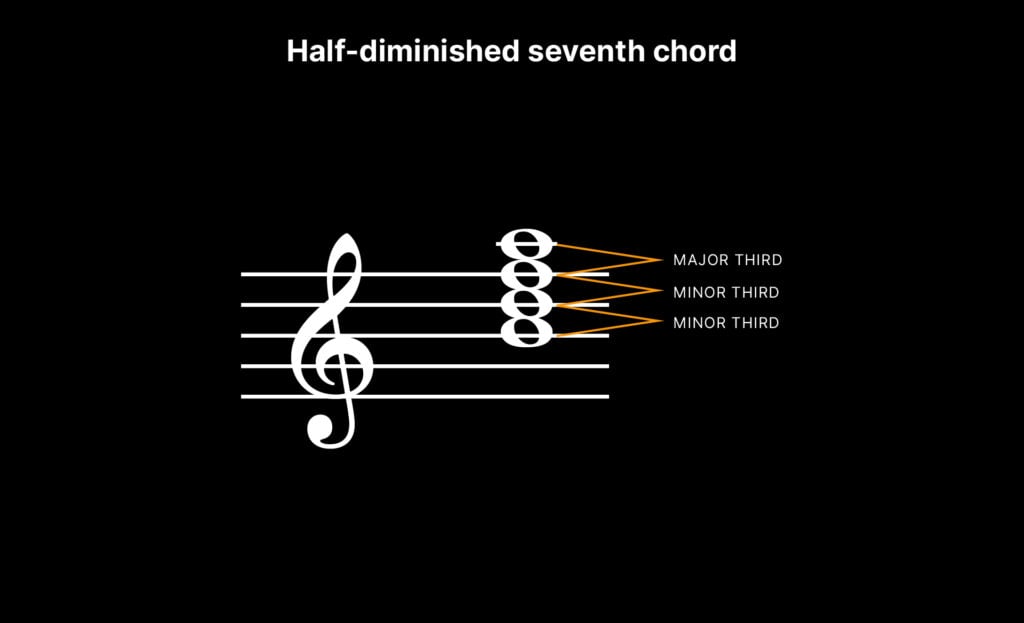Illustration: Daniel Zender
The diminished chord is one of the most underused and underrated chords in popular music.
On the surface, its dissonant sound might make you think there’s no place for it in your music. However, the reality is that diminished chords are a fundamental element of harmony, and have a surprisingly broad range of applications across genres. In this article, we explore what a diminished chord is, how it sounds, and how you can apply it in ways that serve your own music.
Feel free to use the table of contents below to easily jump from section to section.
What you’ll learn:
- What makes a chord ‘diminished?’
- The two types of diminished seventh chords
- The diminished chords starting on every root
- How to use diminished chords in your music
Let’s dive in!
What is a diminished chord?
Let’s start with the basics—what makes a chord ‘diminished?’
A diminished chord is a chord that’s characterized by two intervals: a minor third and a diminished fifth. The most simple version of a diminished chord is a diminished triad, which solely contains these components.

What a diminished triad looks like in sheet music.
What this triad sounds like.
Diminished chord intervals
A minor third is equivalent to three half steps, and this interval makes a frequent appearance in other diatonic triads. For example, the distances from the root to the third in a minor triad as well as the third to the fifth in a major triad are both minor thirds.
On the other hand, diminished fifths—an interval that’s six half steps (also known as a tritone)—are generally less prevalent, and are what give diminished chords their distinctive sound. In a diminished chord, this is the interval from the root to the fifth.
When you arrange a diminished triad in root position (as pictured above), you’ll see that it equates to a stack of two minor thirds, which is a common way people think about the chord. Another popular way to look at it is that it’s “a minor triad, but with the fifth flattened.”

The same chord as above, expressed via MIDI.
Where do diminished chords typically occur?
Diminished triads naturally occur on the seventh scale degree of any major scale, or the second scale degree of any minor scale. For example, in the key of C major, if you build a triad using B as the root note, you’ll naturally get a B diminished triad (consisting of the notes B–D–F).

The two types of diminished seventh chords
Like major and minor chords, the addition of a seventh is one easy way to add some more color to a diminished chord. There are two primary types of diminished seventh chords that you’ll want to be aware of: half-diminished seventh chords and diminished seventh chords (also sometimes referred to as fully-diminished seventh chords). We explain how each of these are structured and identify their differences below.
What is a half-diminished seventh chord?
A half-diminished seventh chord is a chord that consists of a root, a minor third, a diminished fifth, and a minor seventh.

What a half-diminished seventh chord looks like in sheet music.
What this chord sounds like.
Half-diminished seventh chords are what naturally occur when you keep building on that seventh scale degree of any major scale, or second scale degree of any minor scale. Going back to the key of C major, the B half-diminished seventh chord would consist of the notes B–D–F–A.
While this chord also sounds somewhat tense due to the diminished fifth and the added minor seventh interval, it can be used in ways that are actually quite beautiful—we’ll dive into example applications in a bit.
What is a diminished seventh chord?
A diminished seventh chord is like a half-diminished seventh chord, but with one key difference: the seventh is lowered another half-step, turning into a diminished seventh.

What a diminished seventh chord looks like in sheet music.
What this chord sounds like.
The result is a chord that consists of three stacked minor thirds. What’s really interesting about this specific structure is that if we build new diminished seventh chords using each of its individual voices as the root, we’ll end up with chords that all use the same exact set of pitches, once we account for enharmonic equivalence. When we say “enharmonic equivalence,” we mean that the notes might have different names in sheet music, but they’re one and the same in pitch. For example, both B and C♭ sound exactly the same, even though they’re written differently.
So in other words, a B diminished seventh chord (B–D–F–A♭) contains all of the same enharmonic pitches as a D diminished seventh chord (D–F–A♭–C♭), which contains all of the same pitches as an F diminished seventh chord (F–A♭–C♭–E♭♭), which contains all of the same pitches as an A♭ diminished seventh chord (A♭–C♭–E♭–G♭♭).
A B diminished seventh chord, D diminished seventh chord, F diminished seventh chord, and A♭ diminished seventh chord played in succession—they simply sound like inversions of the same chord (because they are)!
Diminished chord chart
Now that we’ve covered diminished triads, diminished seventh chords, and half-diminished seventh chords, below is a chart that spells out all of these chords with each note.
| Root | Diminished triad | Diminished seventh chord | Half-diminished seventh chord |
| C | C – E♭ – G♭ | C – E♭ – G♭ – B♭♭ | C – E♭ – G♭ – B♭ |
| C♯ | C♯ – E – G | C♯ – E – G – B♭ | C♯ – E – G – B |
| D♭ | D♭ – F♭ – A♭♭ | D♭ – F♭ – A♭♭ – C♭♭ | D♭ – F♭ – A♭♭ – C♭ |
| D | D – F – A♭ | D – F – A♭ – C♭ | D – F – A♭ – C |
| D♯ | D♯ – F♯ – A | D♯ – F♯ – A – C | D♯ – F♯ – A – C♯ |
| E♭ | E♭ – G♭ – B♭♭ | E♭ – G♭ – B♭♭ – D♭♭ | E♭ – G♭ – B♭♭ – D♭ |
| E | E – G – B♭ | E – G – B♭ – D♭ | E – G – B♭ – D |
| F | F – A♭ – C♭ | F – A♭ – C♭ – E♭♭ | F – A♭ – C♭ – E♭ |
| F♯ | F♯ – A – C | F♯ – A – C – E♭ | F♯ – A – C – E |
| G♭ | G♭ – B♭♭ – D♭♭ | G♭ – B♭♭ – D♭♭ – F♭♭ | G♭ – B♭♭ – D♭♭ – F♭ |
| G | G – B♭ – D♭ | G – B♭ – D♭ – F♭ | G – B♭ – D♭ – F |
| G♯ | G♯ – B – D | G♯ – B – D – F | G♯ – B – D – F♯ |
| A♭ | A♭ – C♭ – E♭♭ | A♭ – C♭ – E♭♭ – G♭♭ | A♭ – C♭ – E♭♭ – G♭ |
| A | A – C – E♭ | A – C – E♭ – G♭ | A – C – E♭ – G |
| A♯ | A♯ – C♯ – E | A♯ – C♯ – E – G | A♯ – C♯ – E – G♯ |
| B♭ | B♭ – D♭ – F♭ | B♭ – D♭ – F♭ – A♭♭ | B♭ – D♭ – F♭ – A♭ |
| B | B – D – F | B – D – F – A♭ | B – D – F – A |
Note that several of these are enharmonically equivalent—for example, the diminished triads built off of C♯ and D♭ share all of the same pitches, but are simply expressed differently in writing.
How to use diminished chords in your music
Now that we understand how diminished triads, half-diminished seventh chords, and diminished seventh chords are structured, it’s time to tackle the all-important question: How can you actually use them in your music?
The simple answer is that there’s no finite number of ways to use them—music theory is simply a toolbox, not a rulebook! That said, below we take a look at a few ideas that you can consider the next time you’re composing your own progression.
1. An alternative option for dominance
Being naturally built off of the leading tone of a scale makes diminished chords a great alternative option for dominance to the more standard V chord in V—I and V—i moves.
For example, in our music theory analysis of the Naruto opening track “Silhouette,” we looked at how a diminished seventh chord helps create heightened feelings of tension and resolution, at a spot in the progression where we might typically expect a V chord.

Pay particular attention to the fourth chord, also highlighted in the MIDI transcription above.
In this use case, the less consonant harmonies contained within the diminished seventh chord really make the subsequent resolution feel even sweeter when it arrives.
2. A gentle coloration
While dissonance might conjure images of the heavier stylings of metal or the bold explorations of experimental music, it can also be used as a gentle color that expresses vulnerability and wonder.
For example, in our analysis of the so-called “devil’s interval” we showcased how half-diminished chords can substitute traditional options to add a sweet sense of wonder to even a tune that’s as familiar as “Twinkle Twinkle Little Star.”

Not too bad, right?
In the above example, the iiø7 chord (‘ø‘ is the symbol that specifies that a chord is a half-diminished seventh chord, whereas ‘o‘ indicates a fully-diminished seventh) is used to replace a IV chord. This works nicely because the two share a number of pitches in common (F and C), making the swap feel less random.
3. A pivot chord for modulation
Lastly, diminished seventh chords in particular can be used as a powerful pivot chord for modulating to keys that might otherwise feel quite distant from one another. The reasoning for this ties into our previous discussion of how the same set of pitches in these chords can effectively behave as four ‘different’ chords. Following this logic, we can hit this chord in any key, and then resolve to any of the other keys that the chord can connect us to.
Take a listen to 1:12 of the little prelude we whipped up below to hear this in practice.
Modulation? We’ve got it in abundance.
We approach this arpeggiated diminished seventh chord in the key of F minor—but then resolve directly to D minor! These keys are moderately distant from one another (three flats have to be raised to get us to D minor), but because they ‘share’ the same diminished seventh chord, we’re able to move seamlessly between them.
The diminished chord: Conclusion
Hopefully you now have a better idea of what a diminished chord is, and how its sound can be used in a variety of musical applications.
The additional bigger picture to also take away here is just how important of a role context plays in music—in the right setting, dissonance can sound pleasing, while consonance can sound unnerving. As you continue to progress on your musical journey, we hope you keep this in mind and approach music theory as a flexible toolkit for finding new possibilities.
Explore royalty-free melodies, chord progressions, and grooves by key, BPM, genre, and more:
July 5, 2024

.svg)
.svg)




